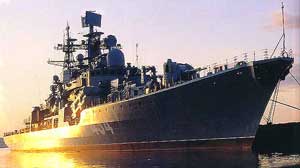|
 The
Pentagon is reportedly investigating allegations that
China has deployed nuclear-tipped missiles on two
Russian-built Sovremenny-class destroyers, said by one
defense expert to be warships designed to initiate a
nuclear war. The
Pentagon is reportedly investigating allegations that
China has deployed nuclear-tipped missiles on two
Russian-built Sovremenny-class destroyers, said by one
defense expert to be warships designed to initiate a
nuclear war.
Reports of nuclear warheads on the new Chinese anti-ship
missiles first appeared inside a new book called
"Red Dragon Rising." According to the book's
co-author, William Triplett, each Chinese warship is
equipped with eight nuclear-tipped, Russian-made Moskit
anti-ship missiles--each armed with a warhead equal to
over 120,000 tons of TNT.
"The Sovremenny is strictly an offensive
platform," stated Triplett during a WorldNetDaily
interview. "Ed (Timperlake) and I are the only two
Americans that have ever been on a Sovremenny,"
said Triplett. "It has virtually no stealth. It
can't hide. It is intended to attack. The vessel is
designed to fire its nuclear tipped missiles and
die."
Triplett also openly charged the missiles arming the new
warships are nuclear-tipped.
"The new missiles are designed specifically to
destroy American carriers and Aegis cruisers with a
single nuclear blast."
According to the U.S. Naval Institute, in August 1999,
the first of two 8,480-ton Russian Navy Project 956A
destroyers built for China conducted trials in the
eastern Baltic. Each 956A warship is armed with eight
supersonic 3M82 Moskit sea-skimming missiles (NATO
code-named SS-N-22 "Sunburn"). The first
Chinese warship was built originally for the Soviet
navy, as the Vazhnyy in 1988.
The ship was launched in May 1994 and renamed the
Yekaterinburg before work was halted. In 1996, the
Chinese People's Liberation Army Navy negotiated to buy
the Yekaterinburg and another 956A class destroyer named
the Alexandr Nevskiy. The Yekaterinburg is due for
delivery by the end of 1999 and the second destroyer by
the end of 2000. In July 1999, Richard D. Fisher, a
defense analyst for Rep. Christopher Cox, R-Calif.,
wrote an evaluation of the Russian-built Moskit missile
being sold to China. According to Fisher, the U.S. Navy
cannot stop the Moskit.
"The Raduga Moskit anti-ship missile is perhaps the
most lethal anti-ship missile in the world," wrote
Fisher in a review of the Chinese navy.
"The Moskit combines a Mach 2.5 speed with a very
low-level flight pattern that uses violent end maneuvers
to throw off defenses. After detecting the Moskit, the
U.S. Navy Phalanx point-defense system may have only 2.5
seconds to calculate a fire solution--not enough time
before the devastating impact of a 750-lb.
warhead."
There is evidence supporting the allegations that the
U.S. Navy cannot stop the Moskit. The only U.S. missile
capable of duplicating the Moskit's blistering low-level
performance is the Allied Signal Vandal. Vandal target
drones are reported to have penetrated U.S. Navy air
defenses during recent trials. However, a Clinton
administration deal with Moscow has left the U.S. Navy
without a means to simulate the Moskit anti-ship missile
threat.
The updated Vandal target drone, re-named the Sea Snake,
was canceled in 1999 by the Clinton administration in
favor of purchasing a Russian target drone, the Zvezda
MA-31. According to official U.S. Navy statements, the
Zvezda MA-31 target drone cannot duplicate the Moskit
performance.
"The U.S. Navy has no defense against this missile
system," stated "Red Dragon Rising"
author Triplett.
"One nuclear-tipped SS-N-22 (Moskit) will kill
thousands of American sailors, airmen and Marines. The
message to the U.S. Navy is clear: Stay away or
die."
PRAVDA Announces New
Moskit SS-N-22 Missile Contract
The Moskit is a large supersonic anti-ship
missile. Designed by the Raduga
Design Bureau, development of the Moskit began in
the 1970s. The Moskit entered Soviet military service in
the 1980s aboard Sovremennyy-class guided missile
destroyers and several classes of fast attack boats.
An air-launched version of the Moskit was first
displayed in 1992, and Raduga also reportedly began
designs for a surface-to-air variant. Neither variant
had entered production as of April 2002.[3,4] The
Moskit's control system is manufactured by NPO Altair.
Missile assembly takes place at the Progress plant in
Arsenyevo in Primorskiy Kray.
The Moskit is powered by a ramjet engine and has an
estimated top speed of Mach 2.5. It has a launch
weight of 3,950kg and carries a payload of 300kg. The
Moskit has a range of 120km (250km air-launched), but
tests of the Moskit using a high trajectory showed the
possibility of increasing its range to 300km. The
air-launched version can be carried by Su-27 and Su-33
fighters. There is no known submarine-launched version
of the Moskit.
Russia's export customers so far include only China,
which purchased two Project 956E Sovremennyy-class
guided missile destroyers armed with Moskit missiles.
China has also recently signed a new contract with
Rosoboroneksport to purchase two more destroyers by
2005. There are also reports that China is expected to
sign contracts for the air-launched version of the
missile.
|